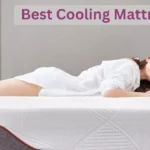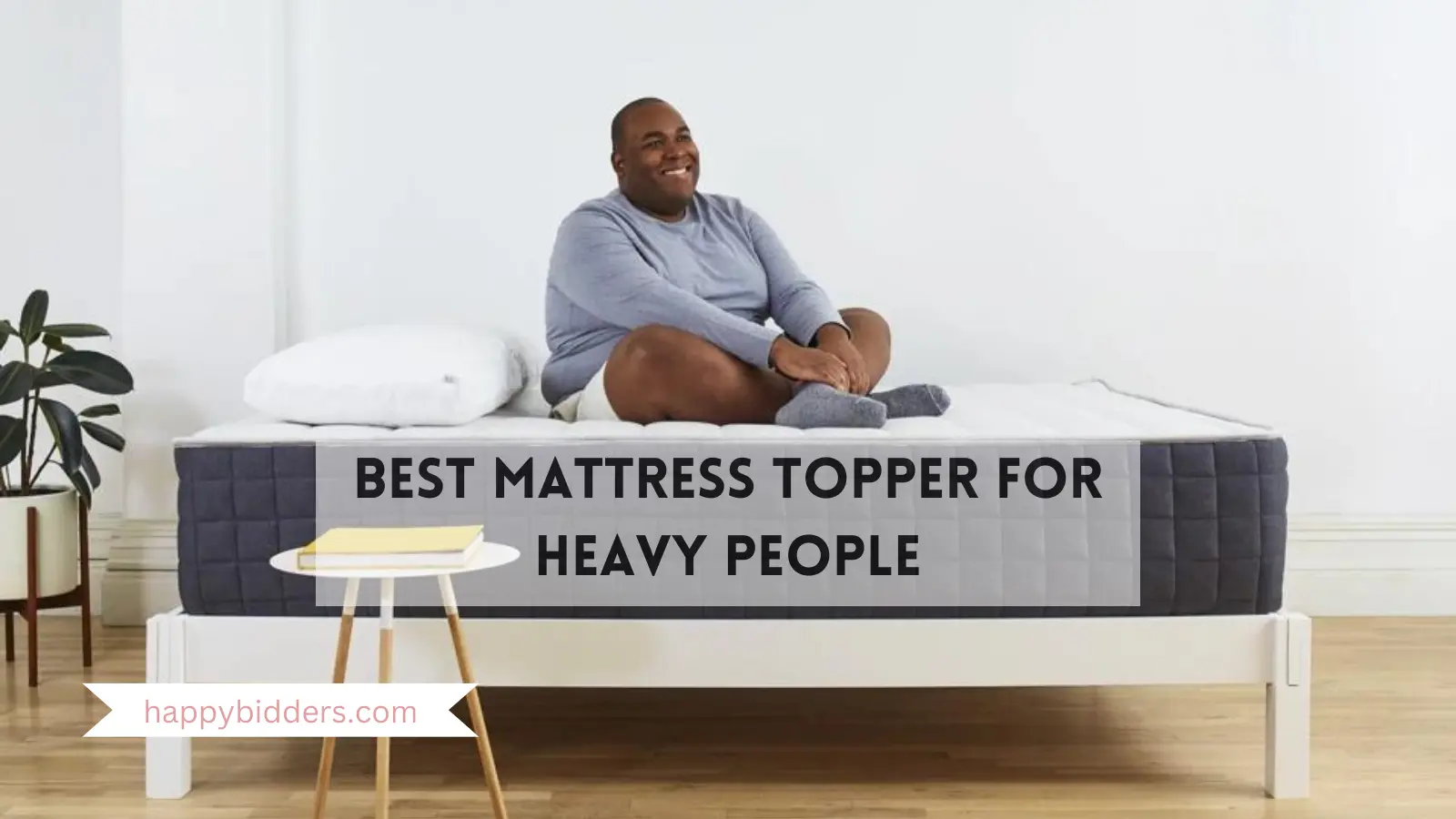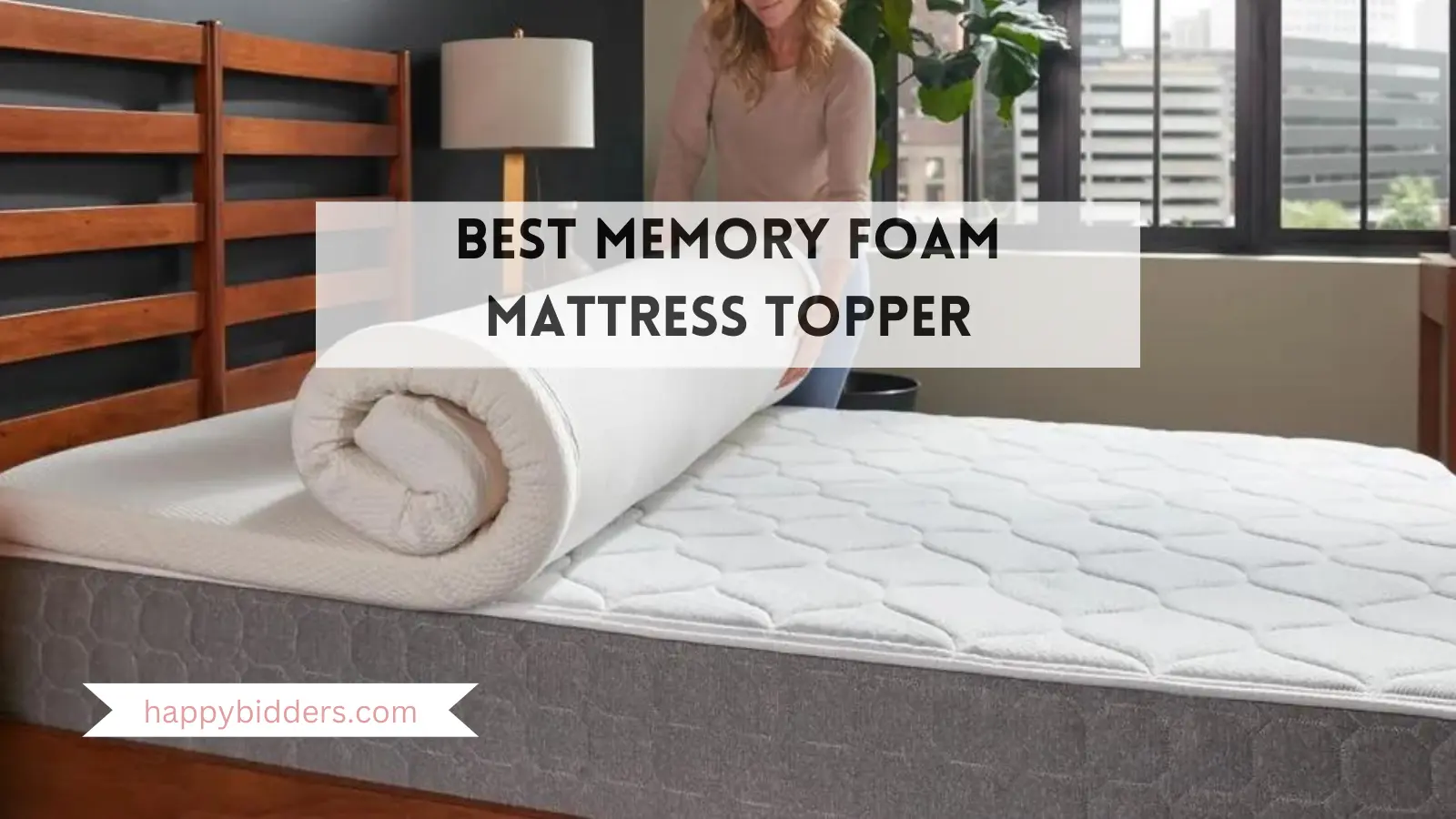Everybody loves crawling into a cozy, comfortable bed at night. But researching, testing, finding, haggling over, and actually buying that perfect mattress? That’s a nightmare for most people.
The mattress industry has a well-deserved reputation for being particularly difficult to navigate. That’s not exactly what you want to deal with when you’re making a relatively expensive purchase that will affect your sleep, your health, and your general well-being.
But recent – and very significant – changes in the industry have resulted in a complete makeover over both of mattresses themselves and the mattress buying process. There is more competition. More information. More innovation. More ways to buy. And more resources for consumers than ever before.
The mattress industry has changed, but the purpose of a mattress remains the same: to give you the very best sleep you can possibly get. Deciding which mattress will do that for you is still a very personal decision. This mattress buying guide will help you determine what mattress is right for you, how and where to buy it, and how much you should pay for it. Read on for all the information you need to find the mattress of your dreams.
When to replace your mattress
Even though buying a new mattress is a lot easier than it used to be, there is still no need to do it unless you have to. Are you thinking it might be time to replace your old mattress? Consider these factors before you haul that old one away:
- Age: Nothing lasts forever, even the most well-made mattress. As a general rule, you should replace your mattress every 8-9 years. Different types of mattresses hold up better than others and other variables – like your body weight and how often you use the mattress – will affect the exact longevity. But no matter what, it is best to ditch most mattresses before they hit a decade.
- Mattress Sagging: Visible signs of wear and tear are a definite red flag. Sagging is especially common with older innerspring mattresses. The result is a valley in the middle of the mattress that inevitably sucks your body in. When you move into that valley, you’re getting less support. And if you sleep with a partner, you’ll find yourselves both rolling into the same spot.
- Body Impressions: As opposed to sagging, a tell-tale sign of a worn out memory foam mattress is a permanent body impression. A good memory foam mattress cradles your body, forming a customized impression every time you lay down. If you’re leaving an impression on your mattress, the foam is no longer responsive. That means the foam is worn down and not customizing to your body anymore or providing you with proper support.
- Pressure Points: If you feel localized pain in specific areas when you are lying down to sleep, this is a sign that you’re mattress has reached the end of its life. Side sleepers might feel this most in their hip and shoulder, for example. This would mean the mattress has deteriorated and is no longer providing you important pressure point relief.
- Back Pain: If you’re waking up with new or noticeably worse back pain, you can likely attribute that to your mattress. And new back pain can oftentimes be attributed to a old mattress. As a mattress wears out, it no longer provides the proper support or pressure point relief. This often results in back pain and muscle soreness throughout the day.
- Upgrade: Maybe your old mattress is still ok, but you’ve decided you’re ready for an upgrade. Considering that we spend nearly one-third of our lives in bed, investing in a quality mattress and a good night’s sleep is always a smart decision in our book. As sleep experts, we believe wholeheartedly in giving yourself the best opportunity for better rest.
How important are the following reasons in your decision to purchase a new mattress?
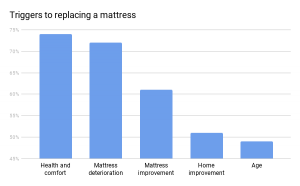
The graph above shows what would trigger a sampling of consumers to replace their old mattresses. As you can see, most consumers responded that their health and comfort would be the most important reason in choosing to upgrade. This reflects that people are equating better sleep to a better general well-being.
Types of mattresses
Innerspring

An innerspring mattress is constructed from steel coils in a range of configurations. Since their invention in 1871, innerspring has been the most widely sold and often least expensive mattress option available.
Construction: An innerspring mattress is comprised of steel coils (springs). These coils range in thickness from 12 (the most easily compressed) to 18 (the firmest). The coils are usually cushioned and encased in a quilted fabric, then topped with one or more comfort layers.
Price Range: Innersprings are often the most affordable mattress option, starting as low as $100. As is usually the case, those looking to spend more can easily do so. The average price for a queen ranges from $800-$1,200.
The Good:
- You can easily choose your firmness preference, with a wide range available.
- Space between the coils allows easy ventilation and a more incredible night’s sleep.
- There are many options available at a range of prices.
The Bad:
- Sagging can become an issue over time.
- Innerspring mattresses can be very heavy and difficult to move.
- The coils tend to create movement transfer. So if you sleep with a partner, you will probably notice each other’s movements more so than in other mattress types.
Hybrid
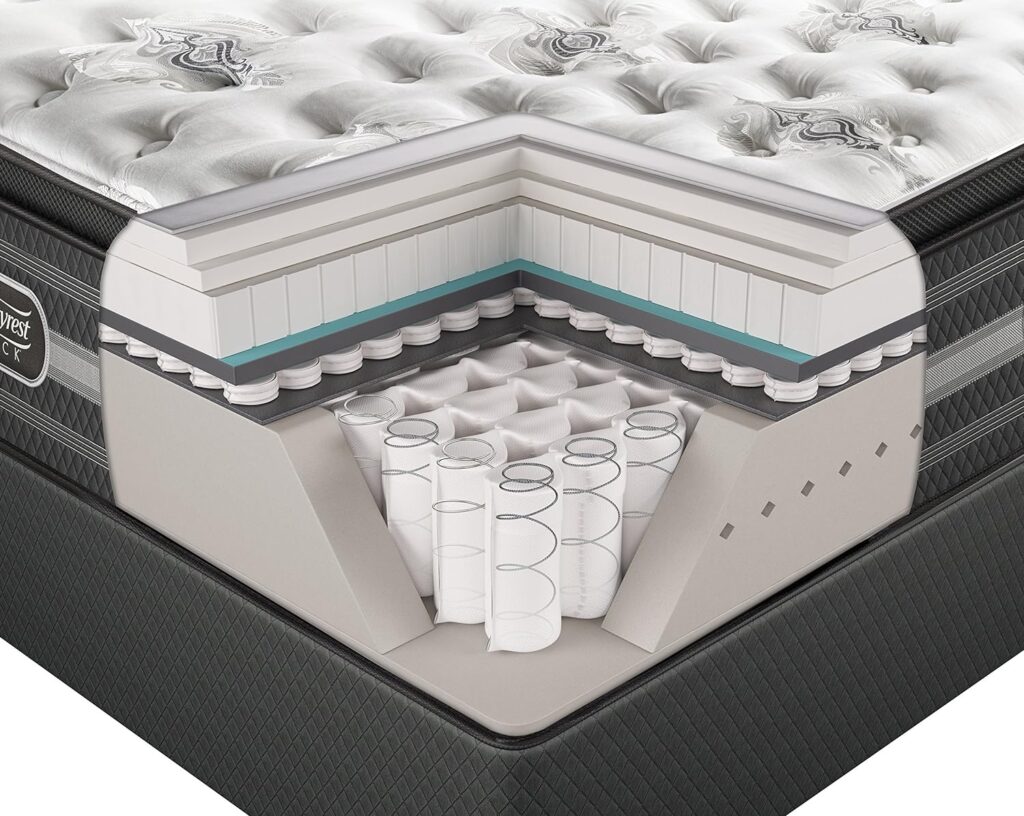
A hybrid mattress combines an innerspring coil system underneath a foam top layer. This provides the pressure-relieving benefits of memory (or latex) foam with the more traditional feel of an innerspring mattress.
Construction: A hybrid mattress uses the same coiled support system as an innerspring mattress for its foundation, but is topped with a thick layer of foam. This foam may be either memory foam or a natural or synthetic latex.
Price Range: Prices for a hybrid mattress vary greatly, ranging from $600-$4,000 and up. Price can depend on the coil system as well as other layering used on top.
The Good:
- A hybrid provides better movement isolation than traditional innerspring mattress.
- You get the comfort and pressure point relief of memory foam, but it doesn’t trap heat.
- Even with the foam layer, the hybrid remains bouncy and suitable for sex.
The Bad:
- With both spring and foam components, a hybrid is heavy and difficult to move.
- This is one of the most expensive mattress options.
- With its coil support system, a hybrid is still prone to eventual sagging.
Foam

Foam mattresses have gained popularity for the customized feel and support they offer sleepers. Memory foam is what consumers typically think of in this category. This specially developed foam – originally created by NASA to provide crash protection – reacts to pressure and heat, allowing it to change shape and mold to the sleeper’s body. Other polyurethane foams with similar properties can also be used to create an experience similar to memory foam, except these poly foams are made to compress, rather than soften, under pressure and heat. A high-resilience polyfoam with a 3.5+ PCF density rating is the highest quality foam available. Polyfoam rated between 1.8-3.5 is considered high-density poly. Both of these foams are dense enough to be used in a support layer. Conventional foam, rated 1.5 PCF and below, is low-quality and not recommended.
Construction: Despite the name, memory foam mattresses are not made entirely from memory foam, as it is too soft to provide adequate support. A support core made from high-density polyfoam creates a sturdy base. It’s topped with the memory foam layer, which make up 25-40 percent of the mattress.
Price Range: A queen-size memory foam mattress can range from $150-$4,000. Price varies based on the density of foam, the amount of foam, and the type of foam used. The higher the density and thicker the layer, the higher the cost will be. Synthetic foams are less expensive, while plant-based or gel-infused foams will cost more.
The Good:
- Foam has excellent contour ability provides support and pressure point relief.
- Superior motion isolation keeps you from disturbing your partner.
- Foam has a longer lifespan than traditional innerspring mattresses.
The Bad:
- Foam mattresses tend to trap heat.
- These mattresses offer little bounce back, making them unsuitable for sex.
- Some sleepers dislike the “sinking” feeling of the mattresses conforming to your body.
Latex
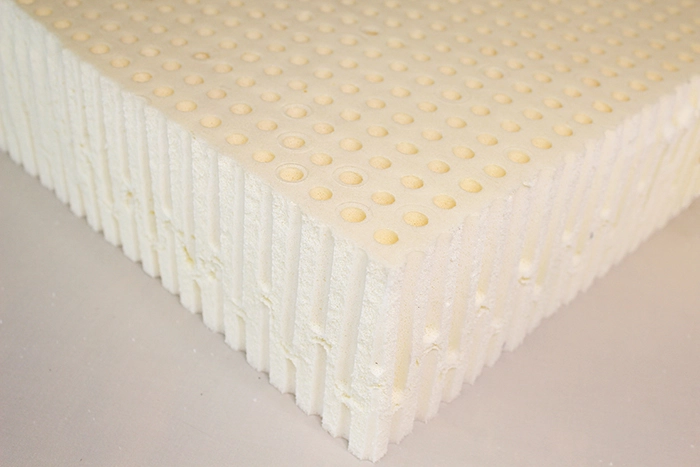
A latex mattress is thought to combine the conforming,, pressure-point relief found in foam mattresses, with the supportive features found in hybrid and innerspring beds. They are available in a variety of firmness levels, making them suitable for a wide range of sleepers. The latex used in these mattresses is derived from the sap of a rubber tree plant.
Construction: Latex beds are typically made entirely of latex. An all-latex bed features a support layer of latex foam, topped with one or more comfort layers of a softer latex. There are two different processes to produce this latex. The Dunlop process produces a dense, sturdy, heavy latex. The relatively new Talalay process, results a latex foam that softer and bouncier. Both are considered 100 percent natural.
Price: A queen latex mattress will cost between $850-$2,400. Price is based on the type and amount of latex used, as well as the number and thickness of the support layers.
The Good:
- Latex beds contour to the body for good pressure point relief.
- A responsive feel offers bounciness suitable for sex.
- These mattresses come in a variety of firmness levels.
The Bad:
- Latex is typically a more expensive option.
- Latex mattresses are available primarily online, making it difficult to try before you buy.
- These mattresses tend to be heavy and difficult to move.
Airbeds
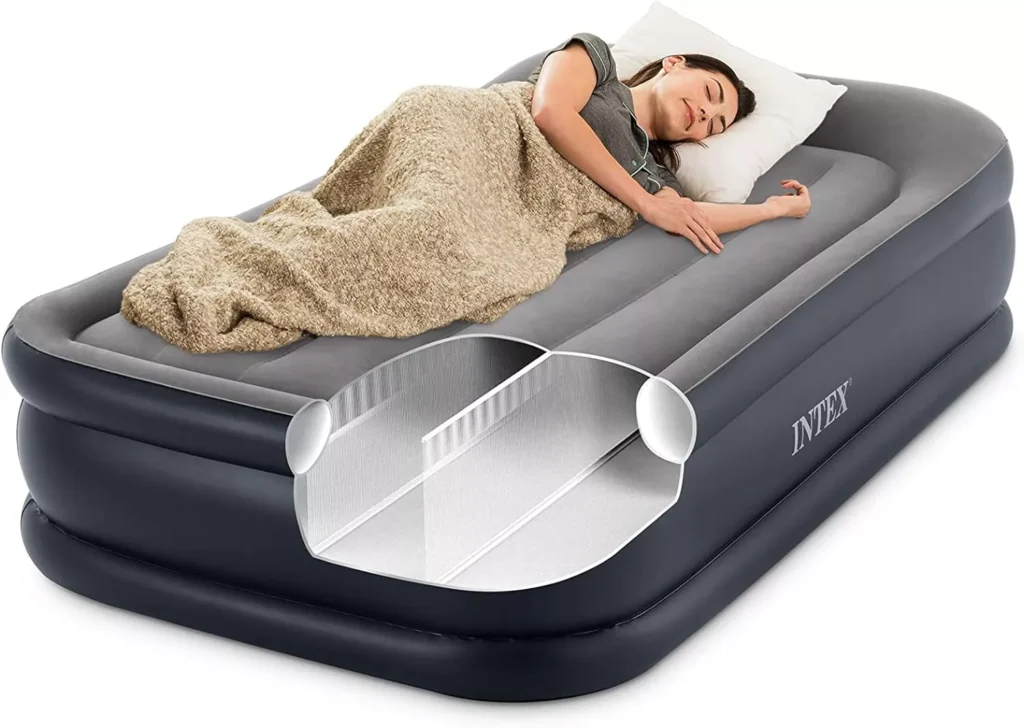
Airbeds are inflated to provide support within a vinyl or rubber chamber.
Construction: An airbed consists of an adjustable vinyl or rubber chamber that is filled with air to provide support. Some models include an extra comfort layer of foam, latex, fiber or the like.
Price: An airbed can cost as little as $20 for a basic, manual blow-up model or thousands of dollars for high-tech options. The average price ranges from $500-$4,000, based on comfort components and technology.
The Good:
- Air mattresses are very light and easy to transport.
- They are adjustable, making them suitable for a wide range of sleepers.
- As they can deflate, air mattresses can be used in a variety of settings.
The Bad:
- Parts can break or wear out over time.
- Air pressure can fluctuate throughout the night.
- Higher quality mattresses tend to be very expensive.
Waterbeds
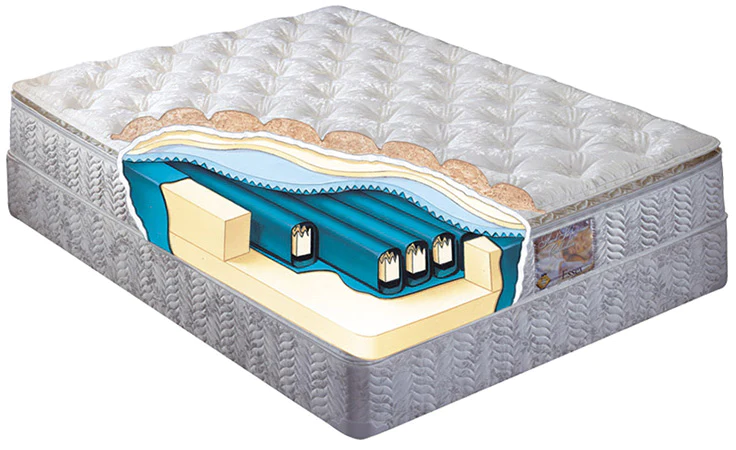
A waterbed uses water as its primary support component. They reached peaked popularity in the 1980s.
Construction: In a waterbed, water is contained in either a vinyl or fabric chamber. They can be either hard or soft sided. A soft-sided waterbed encases the water-containing mattress inside of a sturdy foam framed. With a hard-sided bed, the water chamber is contained inside a wooden frame. Some are topped with a layer of memory foam or gel.
Price: Waterbeds range from $50-$1,800.
The Good:
- Water can be added or removed to adjust firmness.
- These beds are hypoallergenic.
- Water results in minimal surface pressure.
The Bad:
- Waterbeds are cumbersome to move, as they are difficult to drain and very heavy when filled.
- Water provides virtually no support for your back or joints.
- The water-containing chamber can be punctured, resulting in messy leaks.
What to Consider
As you now know, there are many mattress types available, each with different characteristics. The next step is to determine the type that will best suit you. Consider the following:
Firmness
Firmness refers to how a mattress feels when you lie down on it. A firm mattress does not give and offers resistance, or push-back, when depressed. A softer (less firm) mattress will offer more “give” and allow the body to sink down slightly.
There is a common belief that a firmer mattress is better for back pain, but that’s not necessarily true. Firmness is more of a personal preference – there’s no right or wrong answer here aside from what your personal preference is.
Support
Not to be confused with firmness, support is what keeps your body in proper alignment. Without enough support, your body will sink. With too much support, your body will arch. Sleeping in proper alignment allows your muscles to relax and your body to fully rest and recuperate while in bed. Proper support also helps you avoid aches and pains caused by an uncomfortable sleep. The amount of support you need will vary based on your body weight and sleeping position.
Temperature neutrality
Science shows us that higher quality sleep is had at cooler temperatures (around 65 degrees Fahrenheit). Your mattress can absolutely affect this temperature. Some types – such as memory foam – trap heat against your body. This can make for an uncomfortable night, especially if you tend to naturally sleep hot. Other mattresses – like latex and innerspring – allow for more airflow and therefore tend to remain cooler throughout the night.
Motion Isolation
If you sleep with a partner or a pet, it is important to consider motion isolation. That’s a term that describes how well a mattress absorbs movement – and therefore how well it keeps that movement from reaching another sleeper. If a mattress has excellent motion isolation, your partner or pet won’t be as bothered with you adjusting positions or getting out of bed early in the morning.
Edge support
Another important consideration, especially if you sleep with a partner, is edge support. Proper edge support keeps you as comfortable on the edge of the bed as you are in the middle. Mattresses can provide edge support in many ways, from foam encasement to steel rods to firmer coils around the perimeter of the bed. You’ll get a more consistent sleep surface from foam or coils. Innerspring and hybrid mattresses give you better edge support than memory foam mattresses.
Buying online vs. store
One of the most notable changes the mattress industry has ever seen is the recent rise of online retailers. These direct-to-consumer companies have disrupted the game, bringing new innovation, information, and in many cases, lower prices into the industry. Traditional brick-and-mortar mattress stores are adjusting, giving you several ways to buy your best mattress.
Shopping in store
There are four primary places to buy a mattress in person:
Mattress specialty stores: These brick-and-mortar stores sell only mattresses and mattress accessories. You’ll find the most extensive collections here and salespeople with extensive product knowledge. There are several nationwide chain specialty stores as well as local mom-and-pop shops. There will be some room to negotiate prices, especially at the larger (and typically higher-priced) chain stores.
Big box retailers: Big box retailers are stores like Costco or Sam’s Club. The selection here will be limited and inventory may not last long. Don’t expect sales staff to be experts either. But prices are typically lower and the deals are better than what you’ll find at a specialty store.
Furniture stores: Furniture stores will often sell you a new mattress to go with that bedroom set you just bought. And bundling your purchase often gets you a good deal. While furniture stores can be a one-stop shop, the selection will probably be small and the sales staff not quite as able to answer questions.
Department stores: With a large selection of mattresses available to try as well as a dedicated sales staff, department stores like JCPenney and Macy’s can be a good place to start your shopping. But these stores also tend to have the highest prices.
Pros of buying in-store
- It’s easy and convenient to try the bed before you buy it.
- You can see a wide variety of options and easily compare the comfort.
- The sales staff can answer questions and help guide you through the process.
- You can find great deals, especially at big box retailers.
Cons of buying in-store
- It’s difficult to compare the price and features of different mattresses.
- The sales staff can be overbearing or intimidating.
- Returning mattresses can be a hassle – not to mention expensive.
- There is often a lack of transparency, with retailers not providing information about the components within each bed.
- Some stores, especially the big box retailers, don’t allow for in-store mattress testing.
Pros of buying online
- Buying anything online is convenient. You can shop whenever, wherever.
- There is increased transparency online and it’s easy to research your options.
- Pricing is typically lower from online retailers.
- Most websites offer enhanced customer service, either via phone or online chat.
- Online retailers commonly offer a free trial period, with easy returns and refunds if you’re not satisfied with your purchase.
- Free shipping is also common.
Cons of buying online
- The biggest drawback to buying online is that you can’t actually see, touch, and feel the mattress before you buy it. (Though it’s worth noting that some online retailers are setting up showrooms to solve this problem.)
- It’s necessary to do your research, not just on the mattress but on the company that’s selling it. It’s important that the seller has quality customer service both before and after you buy.
How much should you spend?
With so many options available, you can spend as much or as little as you want on a mattress. Prices vary depending on where you buy, what type you buy, and what brand you choose. Here’s a guide of what to expect at each price point, based on a queen mattress.
- $0-$200: Any mattress in this range will use cheaper materials and be of lower quality. The thickness will range from 6-8 inches. There are a variety of options, including foam, innerspring, and hybrid. But keep in mind, a mattress at this cost isn’t built to last and won’t hold up long.
- $200-$400: You will find better options at this price range. Thickness will increase to the recommended 8-10 inches and general quality will be higher. But these mattresses will still contain cheaper materials and their lifespans will be shorter by comparison.
- $400-$600: This is where you start to see higher-quality materials and standard 10-year warranties. There are several mattress types available at this price point, including foam, innerspring, and hybrid. But you won’t have a lot of firmness options.
- $600-$1,000: Options abound in this price range, where you’ll have your pick-up mattress types, firmness levels, and height preferences. Longer warranties are also common. High-quality foam, hybrid, and innerspring mattresses are available in this range. You’ll also start seeing some latex and airbeds priced here, but they will be below-average quality for mattresses of those types.
- $1,000-$2,000: You will find above-average quality foam, hybrid, and innerspring mattresses in this range, but you’ll also see good quality latex and airbed mattresses here. Minimum heights for cost are usually 10 inches. At this price point, you’ll have a large variety of options to try both in-store and online.
- $2,000-$5,000: You can do about anything your heart desires at this high-end price point. Mattresses in this range offer extensive customization and high-quality materials. You’ll have your pick of any mattress type, firmness, and height.
- $5,000+: A mattress at this price would be completely customized and designed specifically for your sleep preferences.
Common mattress myths
As we mentioned, the mattress industry isn’t always easy to navigate and misinformation abounds. Don’t fall for these common mattress myths:
Coil count matters: It doesn’t necessarily. An innerspring mattress will a higher coil count may be better, but only if those coils are made from better material.
Gel foam sleeps much cooler than memory foam: It can. But it doesn’t if it’s buried deep under comfort layers.
Special lumbar support alleviates back pain: The correct support does help alleviate or avoid back pain. But the correct amount varies by person. Too much support can just as easily lead to aches and pains.
Thickness matters: It does. But biggest doesn’t always mean best. Mattresses range from 6 to 15 inches, but the common 8-10 inch range suits most people. If you are of average weight, you won’t feel the benefit of paying extra money for a 15-inch thick mattress.
Do you need a box spring for that new mattress: You probably don’t. New mattresses are typically thick enough that they do not need the extra shock absorption of box springs. As long as your bed frame provides adequate support and a solid platform for your mattress, you can skip the box spring.
One size fits all: With a decision that is as expensive and as important to your health and well-being as a mattress, you should always do your research. It’s true that the average person would probably be happy with the average mattress, but it’s always a good idea to educate yourself before making such a personal purchase. Before buying, consider your sleeping position, age, weight, any medical conditions, and personal preference.
Five minutes trying mattress matters: Many consumers find peace of mind in laying on a mattress before bringing it home. But five minutes in a showroom won’t give you a true feel for how the mattress actually sleeps. The only way to know how a mattress will actually feel is to sleep on it for several hours. So a trial period of at least 30 days is much more important than a showroom test.
Comparison shopping is easier in-store: It’s not. The mattress industry is notorious for making it difficult to compare models and prices. It is common practice for major mattress manufacturers to rename models and significantly change pricing based on very minor changes. Model names and prices can also vary by store. This makes it very difficult to actually compare your options.
In Summary
Ready to start the search for your best mattress? Here are a few key takeaways to remember:
- Try out your your mattress, preferably at home for at least 30 days. The most important thing about a mattress is that it’s comfortable. The only way to know that is by testing it.
- Check for proper support from top to bottom, ensuring you will have proper spinal alignment.
- If you’re buying an innerspring mattress, pocketed coils are your best option.
- Right now, you can find the best prices on the most options with more information online.
- Plan to spend at least $750 for a quality, daily-use mattress that will last between 8-10 years.
- Use BestMattresses.com’s comprehensive mattress information and reviews to narrow your search.
- Reach out to us here if you’d like specific recommendations or additional information.





